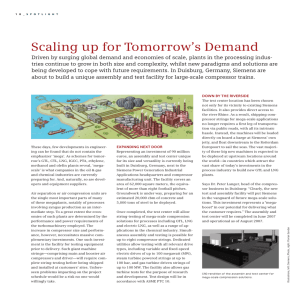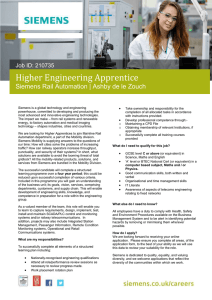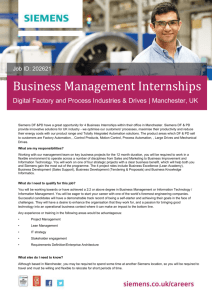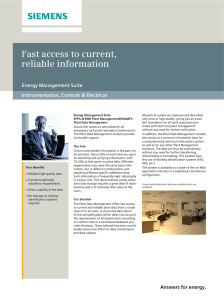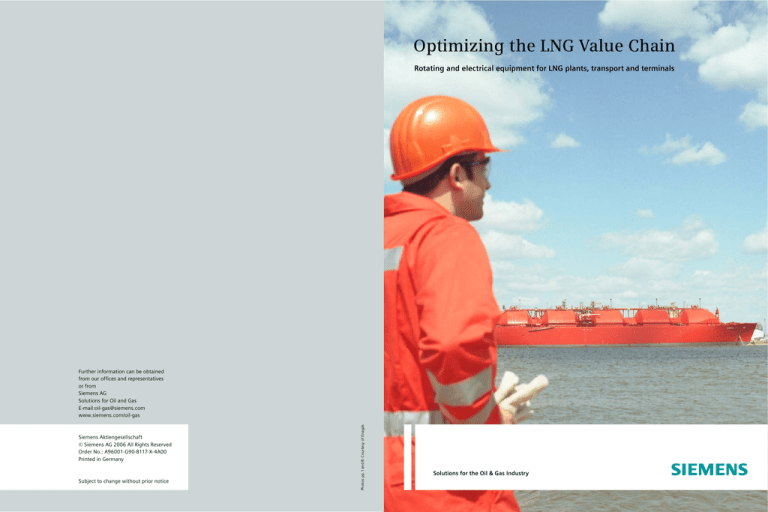
Optimizing the LNG Value Chain
Rotating and electrical equipment for LNG plants, transport and terminals
Siemens Aktiengesellschaft
© Siemens AG 2006 All Rights Reserved
Order No.: A96001-G90-B117-X-4A00
Printed in Germany
Subject to change without prior notice
Photos pp. 1 and 8: Courtesy of Enagás
Further information can be obtained
from our offices and representatives
or from
Siemens AG
Solutions for Oil and Gas
E-mail:oil-gas@siemens.com
www.siemens.com/oil-gas
Solutions for the Oil & Gas Industry
s
Advanced Solutions for LNG
Over the past decades, LNG has matured to become an economically viable as well as a technically proven and manageable scheme for transferring natural gas from remote production locations
to distant consumers. Apart from the global increase in price for primary energy, this development
has been driven by increased competition, economies of scale, an emerging spot market for
LNG, and by substantial advances of technology.
Reducing the specific cost of LNG by upscaling liquefaction trains and increasing their productivity through innovative technologies is a recognized industrial trend. The reduction of greenhouse gas emissions and construction times has become an additional problem, challenging traditional approaches.
Enter Siemens. With a wide range of rotating and electrical equipment, power generation, transmission and distribution systems, water management, automation, telecommunications, industrial IT, security support systems, and life-cycle services, Siemens provides a host of solutions
designed to ensure optimum plant performance in any given technical, environmental, economical and political environment.
Innovative design, excellence in engineering, maximum lifetime value, and compliance with health,
safety, environmental and industry standards are common denominators for all components,
products, systems and services in the Siemens LNG portfolio. Moreover, through its global manufacturing and service network, Siemens ensures maximum customer proximity and local content.
Combining our competence and strengths with yours, we can together boost the profitability of
your investment along the entire LNG value chain.
Compression and Pumping
A portfolio of field-proven compressors, gas turbines, electric drives and
motors and their associated control systems including instrumentation
for virtually all production, transport and process applications in the oil
and gas industry.
Power Generation and Distribution
Comprehensive power solutions, including planning, finance, engineering
and optimization of power grids, gas and steam turbine-based power
plants, transformers, high, medium and low voltage distribution switchgear, substation automation, energy management, network consulting.
Automation and Telecommunication
A unique array of automation and telecommunications products, systems and solutions for field, operation and management levels.
Designed to achieve maximum productivity while realizing substantial
cost savings.
Life-Cycle Services
A portfolio of life-cycle services, including feasibility studies, design
and network studies as well as all levels of preventive and corrective
maintenance, performance enhancement programs, service level
agreements and training.
02
03
LNG Production
Liquefying treated natural gas, the refrigeration facility is at the heart
of any LNG plant. Traditionally, gas or steam turbines are employed to
drive its main refrigerant compressors. However, for a number of years,
alternative schemes with fully e-motor driven compressors are a topic
of much debate at business conferences and trade shows around the
globe – and Siemens has been in the forefront of co-developing the eLNG
concept. As a consequence, we can today offer a choice of traditional
and evolutionary drive systems, each with their own characteristics.
20% in power rating. They are also optimized for maximum periods
between inspections and shortest maintenance downtimes, requiring
just four days of maintenance after 16,000 equivalent operating
hours (EOH) and 16 days after 48,000 EOH. This is, in part, due to the
silo combustors at each side of the gas turbine casing, which can be
accessed by a normal-sized person for inside inspection. What’s more,
the SGT6-2000E and SGT5-2000E can handle both low calorific fuel
gas and gas with a high content of nitrogen.
Making this far-reaching decision about the driver concept at the very
early stages of a LNG project takes some bold thinking but promises
large rewards. Whatever the chosen scheme, it must prove its ability to
match the project requirements of geographical location, infrastructure,
economics, available technologies and personnel, and environmental
regulations. For Siemens, the challenge is to engineer the best possible
solution for any given framework, whether GT-LNG or eLNG.
With a track record of more than 220 installations, these gas turbines
have provided a technical and commercial benchmark in generator
drive applications around the world — applications which are typically more demanding than continuous-load LNG operation.
GT-LNG — Better Solutions.
Next-generation LNG plants will be designed to achieve an annual output of 6 to 8 million tons or more, requiring upwards of 240 MW of
total compressor power for the refrigeration process alone. As a result,
compressors and their respective drivers will be considerably largerscale compared to today’s installed base. Tomorrow’s plants, however,
won’t just be built around larger machines, but better solutions.
eLNG — The Future Concept
Operators and engineering companies around the world are looking to
next-generation LNG plants based on electric motor variable speed
drives due to their convincing economical and operational user benefits.
Empirical evidence from long-term operation, however, won’t be available for some time. However, Siemens can draw on extensive experience with virtually all principal components and systems for all-electric
LNG plant schemes.
Siemens has introduced its renowned SGT6-2000E (ex V84.2, 110 MW
(ISO) at 3,600 rpm) and SGT5-2000E (ex V94.2, 160 MW (ISO) at 3,000
rpm) as LNG mechanical drive gas turbines. These units not only exceed
currently available products in their respective class by approximately
04
For small-size refrigeration trains, Siemens offers the well-proven SGT-600
and SGT-700 mechanical drives, rated ISO 25.5 MW and 30 MW respectively.
Siemens variable speed drive systems (VSDS) have proved their reliability every day over more than 30 years in a plethora of applications, and
are available in power ratings to drive today’s largest compressors. As
main drives for LNG refrigerant compressors they offer the potential for
at least 15 days per year of improved plant availability over today’s gas
turbines — a major achievement with regard to the eLNG design concept, which ultimately calls for 365 days p.a. of uninterrupted production. Together with huge operational advantages, this translates into a
substantial improvement in plant economics.
Depending on the location and size of the export facility, however, the
roughly 300 MW of electric power required to run such a plant may
not be available at or near the project site. A power plant would then
become an integral part of the eLNG facility, enabling it to operate
in self-sustained island mode. Siemens has developed special hardware
and control algorithms that ensure the continuity of the LNG production
process even during upset conditions in the power plant. Side effects
of operating large VSDS in islanded power systems are well known and
understood by Siemens; they can be simulated accurately, and proven
mitigation strategies have been developed to deal with them. With the
utility operating in an n+1 configuration, the overall system offers 15
days of extra production compared to conventional gas turbine compressor drives. The additional investment costs for the power plant are
expected to be compensated within a period of 5 years.
From the very beginning of the company’s operations, power generation
has been a core competence at Siemens. Today, Siemens offers turnkey
power plants and industrial power solutions for just about any size
and type of application, including typical power islands for eLNG plants.
Tailored to match specific power generation, power shedding, and
environmental legislation requirements, advanced power technologies
from Siemens will enhance total plant efficiency significantly.
All-Electric Expertise from a Single Source
Procuring the compression, compression drives and power solutions from
a single source offers a number of benefits for end-users and EPC contractors alike. A single point of contact means a significant reduction of
interfaces, simplifying project management and communications.
Applying a manufacturer’s standardized and modularized solutions can
reduce lead, installation, and commissioning times, and result in lower
installed costs.
As a result, bundling of compression solution, electricity production,
transmission and distribution, as well as automation and control within
an eLNG refrigeration plant is an efficient means to reduce costs and
risk, while meeting tight schedules. At the same time, overall plant operability and availability are improved.
Mastering Performance of Large-Scale Machine Trains
State-of-the-art test-bed facilities in Berlin and Duisburg, Germany, put
Siemens in the vanguard of future mega-scale compression solutions
development — not only for LNG. Operational as of 2007, the Duisburg
facility will allow comprehensive full load string-testing of compression
solutions for tomorrow’s 8+ MTPA LNG plants, ensuring uncompromising
functionality and reliability of motor or turbine-driven compressor trains
before being shipped. Complete VSDS packages have long been load
performance-tested at Siemens’ Berlin Dynamowerk facility. Moreover,
with eLNG “power-to-compression” packages from Siemens, their combined and superimposed control systems can also be functionally tested prior to shipping the I&C equipment to site.
05
LNG Production
Drives for Main Refrigeration Loops
Gas turbines of up to 160 MW (ISO) • Electrical variable-speed drive
systems (VSDS) of 75 to 90 MW as main drives • Electrical variablespeed drive systems (VSDS) from 10 to 40 MW as starter/helper motor,
or modular starter/helper motor/generator packages for gas turbines.
Water-air cooled or water-water cooled electrical systems for all known
environments.
Compressors for Main Refrigeration Loops
Propane compressors of up to 90 MW • Mixed-refrigerant compressors
of up to 90 MW, horizontally or vertically split, nozzles up or down, skid
mounted with integrated or separate lube oil systems.
End-Flash Gas Compression
Compressors of up to 40 MW
Boil-Off Gas Compression
Compressors of up to 15 MW, single and tandem casing
Field Instrumentation and Analytics
Pressure transmitters • Temperature transmitters • Flow meters
• Level measuring instruments • Gas analysers • Remote terminal units
• Level measurement in LNG storage tanks and for pump control
• Level switches for detection of minimum and maximum level in tanks
• Valve positioner for valve control • Chromatograph for determination
of gas composition and quality; measuring of calorific value • Moisture
and dew-point measurement in natural gas
Automation
Integrated distributed control system (DCS) for VSDS and compressor
automation, including associated instrumentation • Advanced operations control solutions • Integrated data visualization software enabling
informed decisions regarding utilization of assets and their operating
efficiency • Energy management and control system (EMCS)
This two-train LNG plant in Oman has been equipped with starter/helper drives for
the gas turbines, achieving a 12.5% increase in production. Siemens scope of supply:
engineering, manufacturing and supply of four VSDS systems as a gas turbine
starter/helper VSDS; converter transformers; containerized LCI frequency converters;
synchronous motors and auxiliaries; tandem-casing BOG compressor type STC-SH
(12-6-A) + STC-SV (10-7-A), the world’s largest BOG single shaft compressor at time
of order. All components were designed in accordance with Shell DEP specifications.
Power Generation
Simple, combined and triple-cycle schemes with gas and steam turbines
including generators and auxiliaries • Heat recovery steam generators
• Water steam cycle solutions • Electrical and controls for supplied
equipment • Cranes and heat, ventilation and air conditioning (HVAC)
for turbine building • Cooling water systems
In 2006, after 34 years of continuous operation in start/stop mode, two Siemens
boil-off gas compressors at Shell’s Brunei LNG loading terminal were inspected for
the first time. Bearings showed negligible wear, but were replaced as part of a preventive maintenance scheme. Delivered in 1972, these were the world’s very first
BOG compressors with adjustable inlet guide vanes — a technology that has become
standard for BOG compression applications.
Power Transmission and Distribution
Network planning and consulting services, including harmonic studies
• High, medium and low voltage switchgear • High-current switchgear
• Bus ducts • Power, distribution and special transformers • Substation
protection, control and automation systems • Energy management
• Motor control center • Emergency diesel generator sets • Uninterruptible power supply systems • Station batteries • Power quality and
power correction • Auxiliaries • All services for substations
Melkøya Island, off Hammerfest, Norway. The world’s first all-electric LNG plant.
Designed for flawless operation at arctic temperatures and rapidly changing operating conditions. Siemens scope of supply: The world's largest variable speed drive
systems (VSDS) rated 65 MW at 3600 rpm for the pre-cooling and sub-cooling compressors; vsds-driven compressor string for the methane mix train; 32-MW VSDS
for the liquefication compressor; CO2 re-injection compressor; harmonic study; load
commutated inverter (LCI) frequency converter units, drive control and fault diagnosis systems; transformers; containerized harmonic filters; converter cooling systems
and auxiliary equipment. Photo courtesy of Statoil.
Abu Dhabi Gas Liquefaction Company Ltd. (ADGAS) contracted Siemens for the modernization and expansion of the power supply and distribution system of the gas
liquefaction plant on “Das Island”. The system is designed to improve security of
supply and increase available power reserves. As part of the project the plant will
have a new medium-voltage switching substation, a new power distribution system
and an additional gas turbine with an output of 30 MW.
In 2005 Pertamina /BP ordered two tandem casing trains for an LNG plant in Indonesia. Siemens scope of supply: two trains
with tandem-casing BOG compressors type STC-SH (10-6-A) + STC-SH (10-6-A); IGV control; dry gas seals encapsulated in
heated seal carrier.
Relying on Siemens’ experience in LNG applications, Nigeria LNG ordered rotating equipment for propane compression for
their Bonny Island LNG project. Siemens scope of supply: three compressor trains, each comprising one horizontally split
single-shaft compressor STC-SH (10-6-A) and electric motor; delivered in 2000.
Ras Laffan, Qatar, RasGas LNG plant. Siemens scope of supply: project management; power distribution system consisting
of: 33 kV GIS and 6.6 kV AIS; annunciation system and medium voltage bus ducts; electrical Integrated Control System
ELICS; telecommunication system (FOTS via Open Transport Network (OTN)); supervision and commissioning services.
The world’s largest end flash gas (EFG) single-shaft compressor was manufactured for Nigeria LNG, NNPC. Siemens scope
of supply: five trains with tandem-casing EFG compressors type STC-SH (14-6-A) + STC-SV (14-8-B), 900 mm impeller diameter, IGV control and dry gas seals encapsulated in heated seal carrier.
07
LNG Transport
When transporting LNG by ship, cost-efficiency is just one factor among
many. Ship operators must meet extremely tight receiving and delivery
schedules along with toughening safety and security regulations and
guidelines at loading terminals. Moreover, ships have to match an
increasing number of environmental regulations and guidelines, affecting, for instance, power generation when moored.
Optimizing flexibility, availability and economy as well as environmental
compliance, Siemens’ portfolios for seagoing vessels integrate all products and services needed for sustained maximization of ship performance, ranging from state-of-the-art solutions for integrated power generation and drive systems with dual-fuel 2-stroke diesel-electric or
COGES schemes, to a host of process peripherals such as boil-off gas
compression.
Moreover, Siemens’ dedicated ship automation solutions integrate all
technological aspects of the LNG carrier, such as the cargo system,
bilge system, ballast system, and other machinery systems, including
dual-fuel engines, gas turbines, two-stroke diesel engines and the electric
propulsion system for electrically driven ships, ensuring lower operating
costs and greater efficiency for shipyard, ship owner, trading partners
and crew alike.
Power Generation and Distribution System
COGES plants with dual-fuel gas turbines of 15 MW • MV generators
• MV switchgear • Propulsion transformers • MV converters • Electric
propulsion motors • Drive control and safety systems • Power management system
Propulsion System
Induction and synchronous motors (direct or gear-type) up to 20 MW
Boil-off Gas
Boil-off gas compressors and drives for re-liquefaction plants of up to
1.3 MW
Integrated Automation Systems (IAS)
Automation platform for machinery and cargo based on a uniform hardand software solution
Cargo Handling
Cargo monitoring and transfer system with ship-to-shore communication
Sensors
Field instrumentation and sensors for machinery and LNG cargo systems
LNG Terminals
Taking integration one step further, Siemens offers a comprehensive
energy supply, automation, drive and IT approach for LNG receiving
terminals — all from a single source. Dedicated plant packages include
integrated automation and control solutions for unloading (jetty,
berthing, mooring), storage plant, storage tanks, boil-off gas compression, vaporiser systems, and send-out.
Based on proven systems such as SIMATIC PCS7, industrial PCs, RAIDbased archiving systems and PROFIBUS network components, these
solutions guarantee maximum reliability up to SIL 3 rating. Pre-engineered standard modules and standard software ensure compatibility
across all processes while at the same time reducing time-to-market.
What’s more, Siemens delivers boil-off gas (BOG) compression solutions
of unparalleled performance. Documented by references, their innovative designs as well as their extraordinary durability and extended operating life made Siemens the worldwide market leader in BOG recovery
technology.
Boil-Off Gas Compression
Compressors from 1.5 to 4 MW • E-motors from 3 to 8 MW
Terminal Management and Automation
Automation and safety systems • Automated loading process • Tank
gauging • Distribution planning • Product reconciliation and inventory
management • Business system integration • Regasification process
automation • Station control (DCS) • Jetty control (DCS) • Emergency
shut down (ESD) • Fire and gas protection • Berth and mooring control
• Ship-to-shore communication
Power Transmission and Distribution
Medium-voltage power supply • Low voltage power supply
• Uninterruptible power supply • Diesel generators
Instrumentation, Actuators
Process instrumentation • Capacitance level measurement systems
• Radar level measurement systems
Infrastructure
CCTV • Intercom • Telephone system (Voice over IP) • Security and
access control • Tracking of maintenance staff
Isle of Grain, Kent, UK; LNG receiving terminal of National Grid Transco (NGT).
Siemens scope of supply: PCS 7; Quadlog; emergency shutdown system (ESD); fire
and gas detection system (F&G); LC500 cryogenic capacitance level measurement
for cryogenic pump control; engineering services.
Providence, Rhode Island, USA; LNG re-gasification facility of Algonquin Gas Transmission Co. Siemens scope of supply: project management; system integration; full
station supervisory control; station control panel; LNG tank and pump area control
panel; gas send-out area control panel (metering); integration of other vendors skid
control panels; station HMI and full Ethernet network integration; testing, start-up
and commissioning; documentation and training.
In 1997, Siemens delivered the world’s first single-shaft turbocompressor for boil-off gas compression at an LNG receiving
terminal. The 2 x 50% machines were designed for the DABHOL LNG Receiving Terminal in India. Siemens scope of supply:
two trains of STC-SH (06-7-A) single-casing compressors with dry gas seals and adjustable inlet guide vanes (IGV).
In 2003, Shell/Total/Mitsui ordered the worldwide first 1 x 100% single-shaft turbocompressor for BOG recovery for the LNG
receiving terminal Altamira. The compressor unit can cope with the large volume fluctuation via IGV control and automatic start-stop operation. Siemens scope of supply: one single-casing STV-SV (06-6-A) BOG compressor with IGV control and
dry gas seals encapsulated in heated seal carrier.

